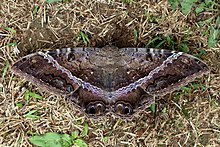
Back أربوسية Arabic اربوسيه ARZ Erebidlər Azerbaijani Еребови Bulgarian Erèbids Catalan Erebidae Czech Erebidae German Ερεβίδες Greek Erebidae Spanish Erebidae Basque
| Erebidae | |
|---|---|

| |
| Black witch moth Ascalapha odorata, Brazil | |
| Scientific classification | |
| Domain: | Eukaryota |
| Kingdom: | Animalia |
| Phylum: | Arthropoda |
| Class: | Insecta |
| Order: | Lepidoptera |
| Superfamily: | Noctuoidea |
| Family: | Erebidae (Leach, 1815) |



The Erebidae are a family of moths in the superfamily Noctuoidea. The family is among the largest families of moths by species count and contains a wide variety of well-known macromoth groups. The family includes the underwings (Catocala); litter moths (Herminiinae); tiger, lichen, footman and wasp moths (Arctiinae); tussock moths (Lymantriinae), including the arctic woolly bear moth (Gynaephora groenlandica);[1] fruit-piercing moths (Calpinae and others); micronoctuoid moths (Micronoctuini); snout moths (Hypeninae); and zales, though many of these common names can also refer to moths outside the Erebidae (for example, crambid snout moths). Some of the erebid moths are called owlets.
The sizes of the adults range from among the largest of all moths (around 12 in (305 mm) wingspan in the white witch) to the smallest of the macromoths (0.25 in (6 mm) wingspan in some of the Micronoctuini). The coloration of the adults spans the full range of dull, drab, and camouflaged (e.g., Zale lunifera and litter moths) to vivid, contrasting, and colorful (e.g., Aganainae and tiger moths). The moths are found on all continents except Antarctica.